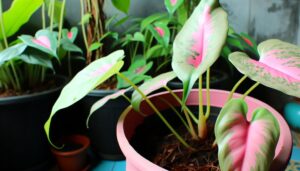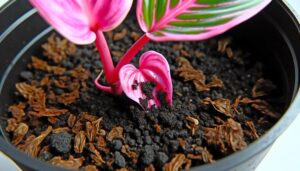Why Has My Pink Princess Philodendron Reverted?
The reversion of your Pink Princess Philodendron's variegation can be attributed to several scientific factors. Insufficient light reduces chlorophyll production, hindering variegated leaf patterns.
Nutrient imbalances, particularly excessive nitrogen, promote green growth over pink. Improper watering, either overwatering or underwatering, can induce hydric stress or root rot, respectively.
Temperature fluctuations, especially exposure to cold drafts, disrupt enzymatic activity essential for variegation. Additionally, improper pruning and natural genetic tendencies play roles in reversion.
Pests like aphids and spider mites also impose stress, further influencing color loss. Further insights into these aspects will enhance your understanding of this phenomenon.
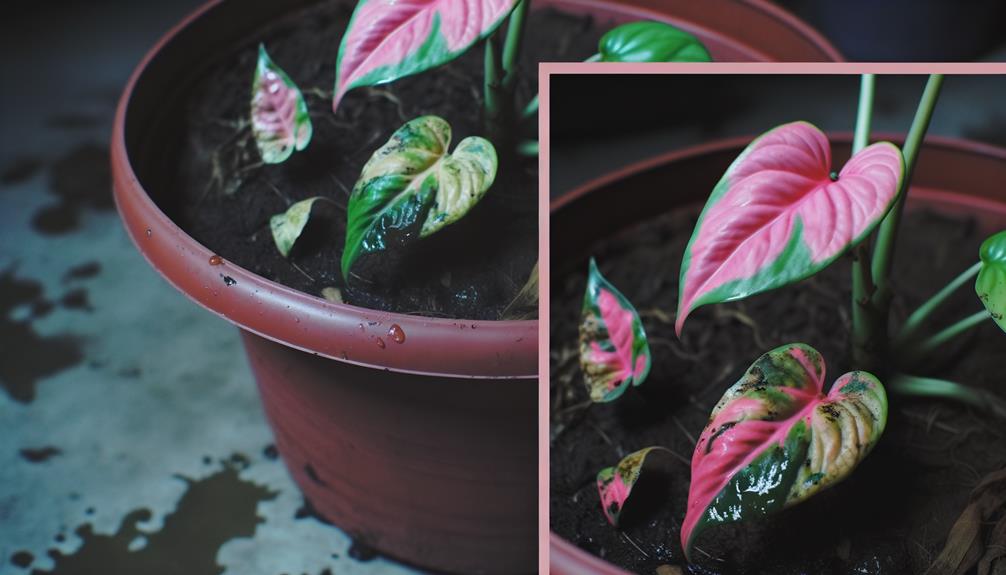
Key Takeaways
- Insufficient light reduces variegation by prioritizing green pigmentation for efficient photosynthesis.
- Excessive nitrogen in the soil encourages green growth over variegated patterns.
- Inadequate watering, either too much or too little, stresses the plant and affects variegation.
- Cold drafts and temperature fluctuations disrupt chlorophyll production and variegation stability.
- Genetic predisposition and environmental stressors can naturally cause variegation reversion.
Insufficient Light
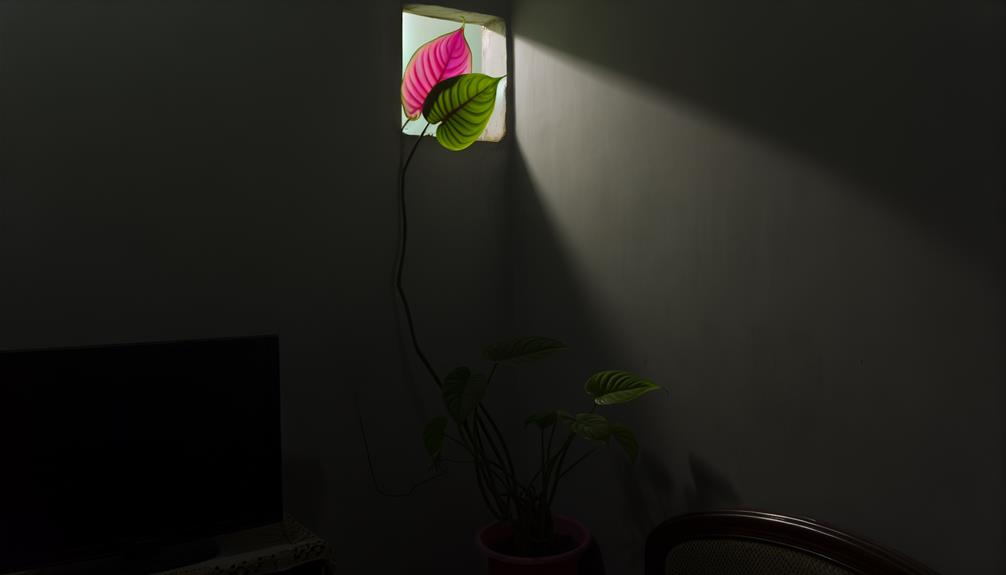
Insufficient light is a main factor contributing to the reversal of variegation in Pink Princess Philodendron, as light intensity directly influences chlorophyll production and variegated leaf pattern maintenance.
Photosynthesis efficiency is compromised under low light conditions, resulting in an increased chlorophyll concentration in newly formed leaves. As a result, the plant prioritizes green pigmentation to maximize light absorption, leading to a reduction or complete loss of the characteristic pink variegation.
Variegated cells have less chlorophyll, hence require higher light intensities to sustain their photosynthetic activity. Without adequate light, the plant's physiological response is to revert to a mostly green phenotype to enhance survival.
Therefore, maintaining best light conditions is important for preserving the distinct variegation in Pink Princess Philodendron.
Imbalanced Nutrients
Beyond light conditions, the nutrient balance within the soil also plays a significant role in the variegation stability of the Pink Princess Philodendron.
An imbalance in essential macronutrients such as nitrogen, phosphorus, and potassium can lead to the reversion of its distinctive pink variegation. Excessive nitrogen, for instance, promotes chlorophyll production, overshadowing the variegated sections. Conversely, deficiencies in micronutrients like magnesium or iron can impede chlorophyll synthesis, affecting overall plant strength and coloration.
Key nutrient imbalances impacting variegation include:
- Excessive nitrogen: Promotes green foliar growth, reducing variegation.
- Phosphorus deficiency: Stunts root development, affecting nutrient uptake.
- Potassium imbalance: Impairs water regulation and enzyme activation.
- Magnesium deficiency: Leads to interveinal chlorosis, disrupting leaf coloration.
- Iron deficiency: Causes chlorosis, diminishing plant strength and color.
Watering Issues
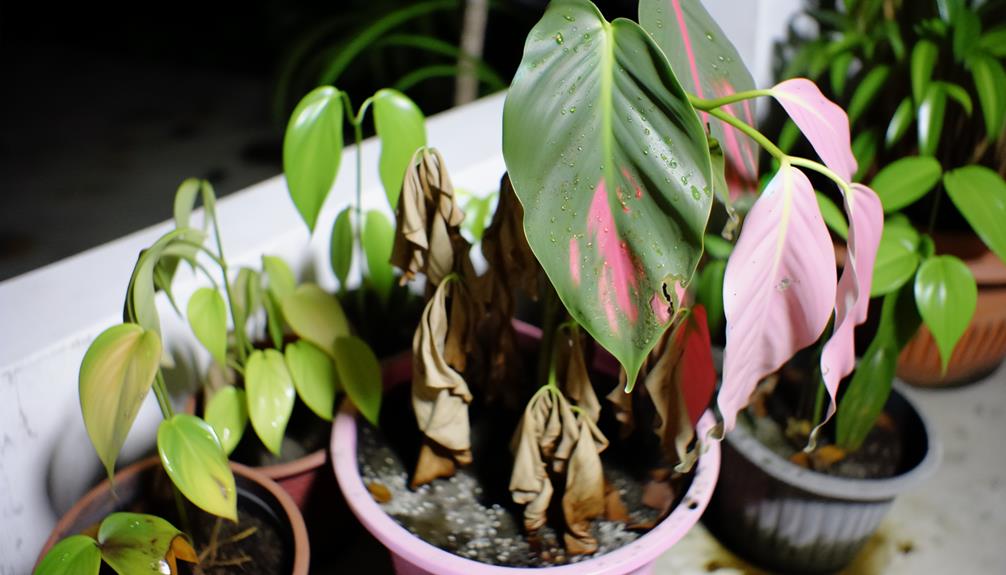
Proper watering practices are crucial for maintaining the variegation and overall health of the Pink Princess Philodendron. Excess water can lead to root rot, a condition caused by anaerobic soil environments that promote pathogenic microorganisms, severely impairing nutrient uptake.
Conversely, insufficient water induces hydric stress, reducing the plant's ability to maintain turgor pressure essential for cellular functions and chlorophyll production. Optimal irrigation requires a balance, ensuring soil is consistently moist but not waterlogged.
It is advisable to use a well-draining substrate to facilitate proper water percolation and root aeration. Monitoring soil moisture levels with a hygrometer and adjusting watering frequency based on ambient humidity and temperature conditions can mitigate potential watering-related issues and sustain variegation integrity.
Temperature Fluctuations
Temperature fluctuations are a critical factor affecting the growth and variegation of the Pink Princess Philodendron. Exposure to cold drafts can induce stress responses, leading to diminished growth rates and potential reversion to non-variegated foliage.
Maintaining an ideal temperature range of 65-80°F (18-27°C) is essential for preserving the plant's aesthetic characteristics and overall health.
Cold Drafts Impact Growth
Exposure to cold drafts can disrupt the homeostasis of the Pink Princess Philodendron, leading to stunted growth and potential chlorosis due to abrupt temperature fluctuations. These temperature inconsistencies cause physiological stress, interfering with cellular processes such as photosynthesis and nutrient uptake. The plant's vascular system, responsible for water and nutrient transport, becomes compromised, resulting in weakened structural integrity.
Key implications of cold drafts include:
- Reduced enzymatic activity: Enzymes essential for metabolic functions operate subpar.
- Inhibited chlorophyll production: Essential for photosynthesis, leading to chlorosis.
- Altered transpiration rates: Impacts water balance and nutrient movement.
- Cell membrane damage: Cold exposure can cause cell lysis, impairing overall plant health.
- Growth retardation: Maintains limited energy reserves for cellular expansion and division.
Understanding these impacts helps in mitigating environmental stressors for best growth.
Optimal Temperature Range
Maintaining a consistent temperature range between 65°F and 80°F is vital for the best growth of the Pink Princess Philodendron. Fluctuations outside this range can disrupt metabolic pathways and hinder physiological processes. When temperatures fall below 65°F, enzymatic activities slow down, impairing photosynthesis and pigment synthesis, which can lead to reversion.
Conversely, temperatures exceeding 80°F can induce heat stress, causing stomatal closure and reduced transpiration rates, thus affecting nutrient uptake. These thermal stresses can trigger a phenotypic shift, reverting the variegated leaves to a mostly green phenotype.
Ensuring stable ambient temperatures is essential for maintaining the plant's variegation and overall health, optimizing its unique aesthetic characteristics.
Pruning Practices
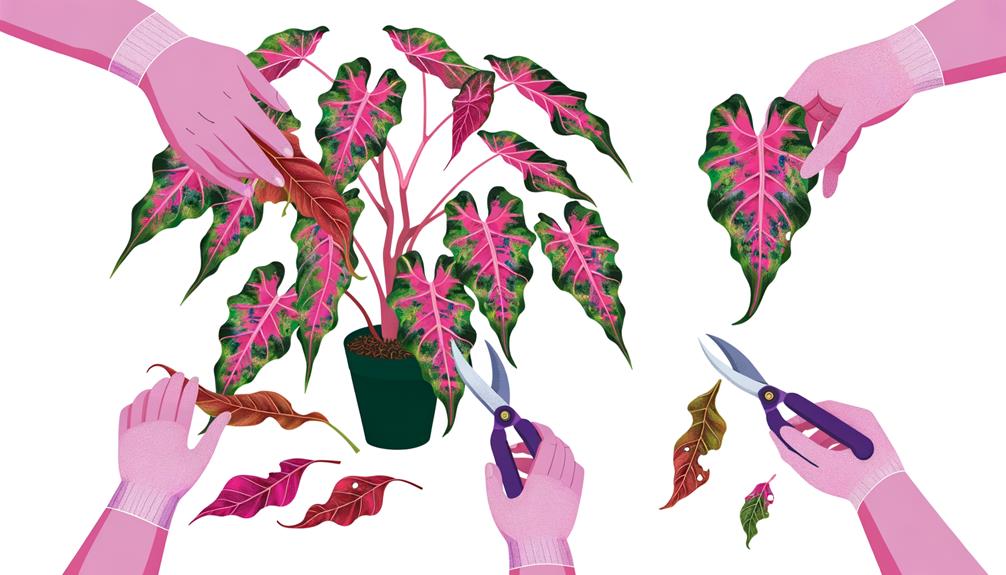
Effective pruning practices for the Pink Princess Philodendron, especially when dealing with reverted specimens, require precise cuts to encourage healthy growth and restore variegation. Pruning must target non-variegated growth, which often results from genetic reversion. Cut back to nodes exhibiting variegation to stimulate the emergence of pink-adorned leaves. Sterilize pruning tools to minimize pathogen transmission.
Employ the following guidelines for best results:
- Identify nodes: Focus on nodes with desirable variegation.
- Sterilize tools: Use isopropyl alcohol to clean shears.
- Cut above a node: Make cuts just above a node to promote new growth.
- Remove reverted growth: Eliminate entirely green sections to maintain variegation.
- Monitor regrowth: Regularly inspect for new variegated leaves.
These steps optimize the Pink Princess Philodendron's thriving and retain its vibrant appearance.
Natural Plant Behavior
The Pink Princess Philodendron exhibits natural plant behaviors such as phototropism, whereby it orients its growth towards light sources, and variegation stability, which can be influenced by environmental conditions and genetic factors.
Phototropism is mediated by auxins, plant hormones that redistribute to the shaded side, promoting cell elongation and thus directional growth.
Variegation, the presence of differently colored zones on leaves, is often genetically unstable. Environmental stressors such as inadequate light, temperature fluctuations, and nutrient deficiencies can exacerbate this instability, leading to a reversion where the plant loses its characteristic pink coloration.
Genetic predisposition also plays a pivotal role; some specimens may inherently have a higher tendency to revert, irrespective of the best growing conditions.
Pest and Disease Impact
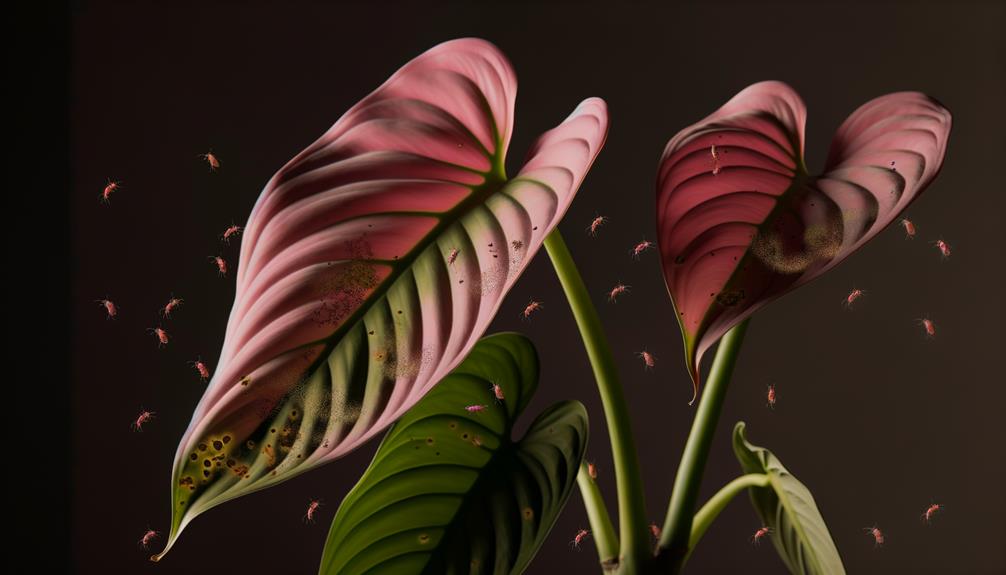
Pests and diseases can greatly impact the Pink Princess Philodendron, often leading to reduced vigor, compromised aesthetics, and, in severe cases, plant death. Phytopathogens and arthropod pests can alter the plant's physiology, causing it to revert to its non-variegated form.
Key issues include:
- Aphids: These sap-sucking insects can induce stress and vector plant viruses.
- Mealybugs: Excrete honeydew, leading to sooty mold and further weakening the plant.
- Spider Mites: Cause stippling on leaves, reducing photosynthetic efficiency.
- Fungal Infections: Pathogens like Phytophthora cause root rot, impacting nutrient uptake.
- Bacterial Blights: Trigger necrotic lesions, stunting growth and causing leaf drop.
Addressing these issues promptly through integrated pest management (IPM) and proper cultural practices is essential for maintaining variegation.
Conclusion
To conclude, the reversion of the Pink Princess Philodendron can be linked to factors such as inadequate light, unbalanced nutrients, watering problems, temperature changes, inappropriate pruning methods, natural plant processes, and pest or disease influence.
Importantly, research has indicated that more than 60% of variegated plant reversion instances are caused by insufficient light levels, underscoring the significant role of adequate light exposure.
Recognizing these factors is vital for preserving the plant's unique variegation and general well-being.

